- By Region
- Central Coast
- Central Valley
- Desert
- North Coast
- Northeast
- SF Bay Area
- Sierra Foothills
- Southern California
- Tahoe Basin
- By Type
- Trees
- Aquatic Plants
- More Info Don't Plant a Pest Home
Invasive Ground Covers of the Bay Area
-
Hedera spp (ivies)

Hedera helix Hedera helix English ivySome ivy species in the Hedera genus are a problem in California. They can smother understory vegetation, kill trees, and harbor non-native rats and snails. It's difficult to distinguish problem species from less invasive ones. Do not plant ivy near natural areas, never dispose of ivy cuttings in natural areas, and maintain ivy so it never goes to fruit. Researchers hope to determine which ivies can be planted safely.
Invasive: Do Not Plant -
Carpobrotus edulis

Carpobrotus edulis Carpobrotus edulis highway iceplantThis vigorous groundcover forms impenetrable mats that compete directly with native vegetation, including several rare and threatened plants. Small mammals can carry seeds of iceplant from landscape settings to nearby natural areas. Pieces of the plant can be washed into storm drains and into natural areas where they become established.
Invasive: Do Not Plant -
Vinca major (periwinkle)

Vinca major Vinca major periwinkle; bigleaf periwinkle; greater periwinkle; blue periwinkle; myrtleThis aggressive grower has trailing stems that root wherever they touch the soil. Their ability to resprout from stem fragments enables periwinkle to spread rapidly in shady creeks and drainages, smothering the native plant community.
Invasive: Do Not Plant -
Helichrysum petiolare (licorice plant)

Helichrysum petiolare Helichrysum petiolare licorice plantSeeds are wind dispersed, and the spreading branches will root at any point of contact with the ground. Licorice plant has been found displacing native plants in the Golden Gate National Recreation Area and other sensitive coastal areas.
Invasive: Do Not Plant
Recommended Ground Covers for the Bay Area
-
Teucrium fruticans

Teucrium fruticans Teucrium fruticans bush germanderThis plant has loosely-branching silvery stems, gray-green leaves, and lavender flowers for most of the year.
Sun:Water: -
Trachelospermum asiaticum

Trachelospermum asiaticum Trachelospermum asiaticum ivory star jasmineEvergreen, vining groundcover up to 20 feet across. Has glossy, dark green leaves and pale yellow, pinwheel-shaped flowers with a jasmine scent.
Sun:Water: -
Rubus pentalobus

Rubus pentalobus Rubus pentalobus Taiwan raspberryForms a highly textured, evergreen ground cover that supresses weeds. Foliage can turn a beautiful scarlet color in fall. Yellow, raspberry-like fruit is edible fresh or in preserves.
Sun:Water: -
Salvia leucophylla
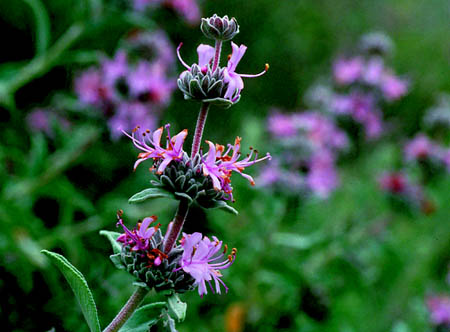
Salvia leucophylla Salvia leucophylla coast purple sageA California native with graceful silvery-green leaves, arching branches, and whorls of purple flowers in the spring and summer.
Sun:Water:Bay Area native -
Teucrium chamaedrys or lucidrys
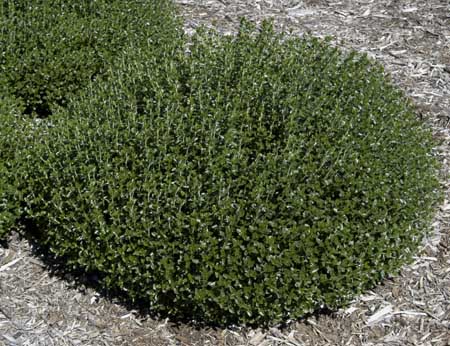
Teucrium chamaedrys or T. x lucidrys Teucrium chamaedrys or T. x lucidrys germander or wall germanderThis plant can be sheared into a neat groundcover or allowed to grow to full height (about one foot), and produces lavender flowers in the spring. Compact cultivars are available. Deer resistant.
Sun:Water: -
Osteospermum fruticosum

Osteospermum fruticosum Osteospermum fruticosum freeway daisyProduces copious cheerful flowers, even under the harshest conditions. Grows well along the coast.
Sun:Water: -
Pachysandra terminalis
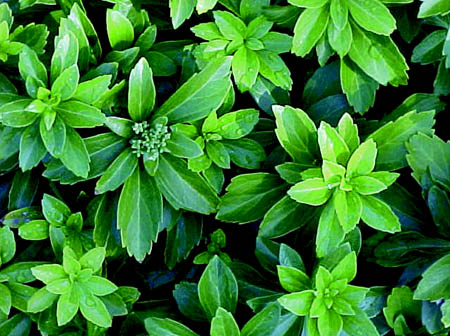
Pachysandra terminalis Pachysandra terminalis pachysandraGrows more slowly than Vinca spp. and Hedera spp., but has a crisp, neat growth form. New foliage is bright green, changing to dark green with age. Small white flowers on 1-2 inch spikes. Withstands shade and is widely used under trees. Variegated cultivars are available. Deer resistant.
Sun:Water: -
Drosanthemum floribundum

Drosanthemum floribundum Drosanthemum floribundum showy dewflower or rosea iceplantA succulent with silver-gray leaves and an abundance of pink flowers. Tolerates some salt spray.
Sun:Water: -
Helleborus foetidus
Helleborus foetidus bear's foot helleboreUnusual foliage and delicate, complex flowers. The intriguing pale green and purple flowers often have a pleasant fragrance.
Sun:Water: -
Heuchera maxima

Heuchera maxima and hybrids Heuchera maxima and hybrids giant alumroot or coral bellsThis evergreen groundcover has heart-shaped leaves and thin, bell-shaped, pink and white flowers that hang gracefully from thin stalks. Fire resistant.
Sun:Water:Bay Area native -
Campanula poscharskyana

Campanula poscharskyana Campanula poscharskyana Serbian bellflowerProduces a profusion of lilac-blue, star-shaped flowers spring to fall. Grows quickly and easily, but could overwhelm a carefully manicured garden. Deer resistant.
Sun:Water: -
Delosperma cooperi
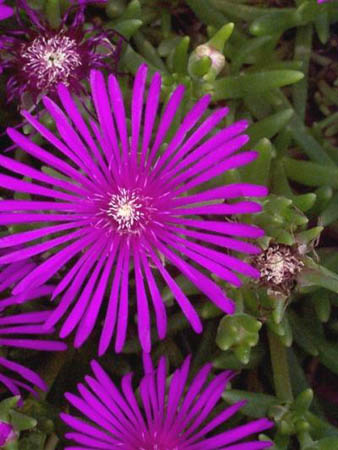
Delosperma cooperi Delosperma cooperi hardy iceplantA non-invasive iceplant with smaller, succulent leaves and brilliant violet-pink flowers May through October. Salt tolerant. Fire resistant.
Sun:Water: -
‘Powis Castle’ Artemisia
Artemisia sp 'Powis Castle' ArtemisiaThis handsome plant has finely divided, gray foliage that grows to three feet tall. Lush and quick growing, it is best for an informal garden.
Sun:Water: -
Asarum caudatum

Asarum caudatum Asarum caudatum wild gingerA California native, this evergreen groundcover has heart-shaped leaves and unusual maroon flowers.
Sun:Water:Bay Area native -
Bergenia cordifolia
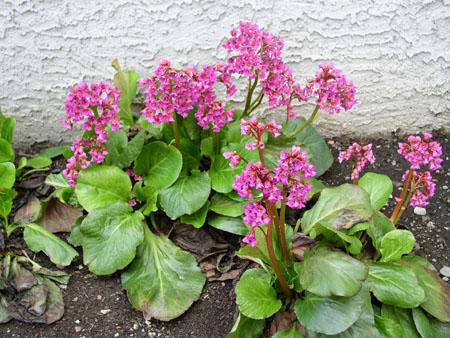
Bergenia cordifolia Bergenia cordifolia bergenia or winter saxifrageAn evergreen groundcover, with large, dark green leaves, and clusters of bright, deep pink flowers.
Sun:Water:
Invasive Ornamental Grasses of the Bay Area
-
Cortaderia subspecies

Cortaderia jubata Cortaderia jubata jubatagrass; pink pampasgrass
Cortaderia selloana Cortaderia selloana pampasgrass; white pampasgrassWind can carry the tiny seeds of these plants up to 20 miles. The massive size of each pampas grass plant with its accumulated litter reduces wildlife habitat, limits recreational opportunities in conservation areas, and creates a fire hazard.
Invasive: Do Not Plant
Recommended Ornamental Grasses for the Bay Area
-
Muhlenbergia lindheimeri

Muhlenbergia lindheimeri Muhlenbergia lindheimeri Lindheimer's muhly grassThis large, dependable, and showy ornamental grass has blue-gray foliage and flowering spikes in the fall and winter. Good in poor soils, it grows up to five feet tall. Works well as a specimen plant or massed into an attractive border.
Sun:Water: -
Nolina bigelovii
Nolina bigelovii Bigelow's bear grassThis agave can be mistaken for a large bunchgrass. Grows up to six feet tall, producing large, striking, white flowers in summer.
Sun:Water: -
Carex spissa

Carex spissa Carex spissa San Diego sedgeThis large sedge has a form similar to that of an ornamental grass. Produces gray leaves to five feet tall and yellow, grass-like flowers in the spring. Deer resistant.
Sun:Water: -
Chondropetalum tectorum

Chondropetalum tectorum Chondropetalum tectorum Cape thatching reedThis decorative, "grass-like" plant produces attractive flowers that are ideal in cut flower arrangements. Grows three to four feet tall.
Sun:Water:
Invasive Shrubs of the Bay Area
-
Cotoneaster
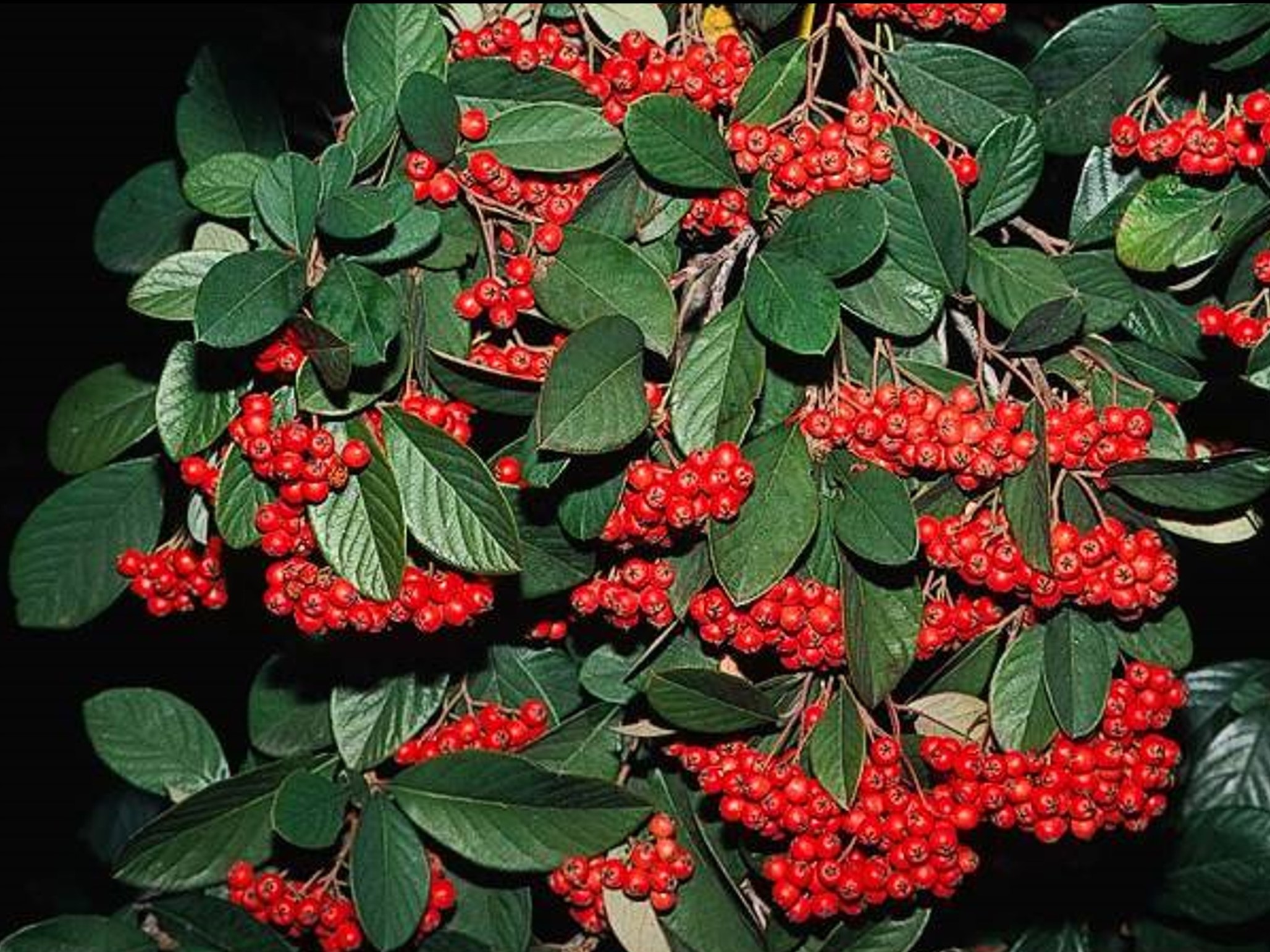
Cotoneaster lacteus Cotoneaster lacteus milkflower Cotoneaster; Parney's Cotoneaster
Cotoneaster pannosus Cotoneaster pannosus silverleaf Cotoneaster; velvet CotoneasterBirds have spread the berries and seeds of these shrubs to many different habitat types. With their rapid growth and competitive roots, cotoneasters displace native plants and animals.
Invasive: Do Not Plant -
Brooms
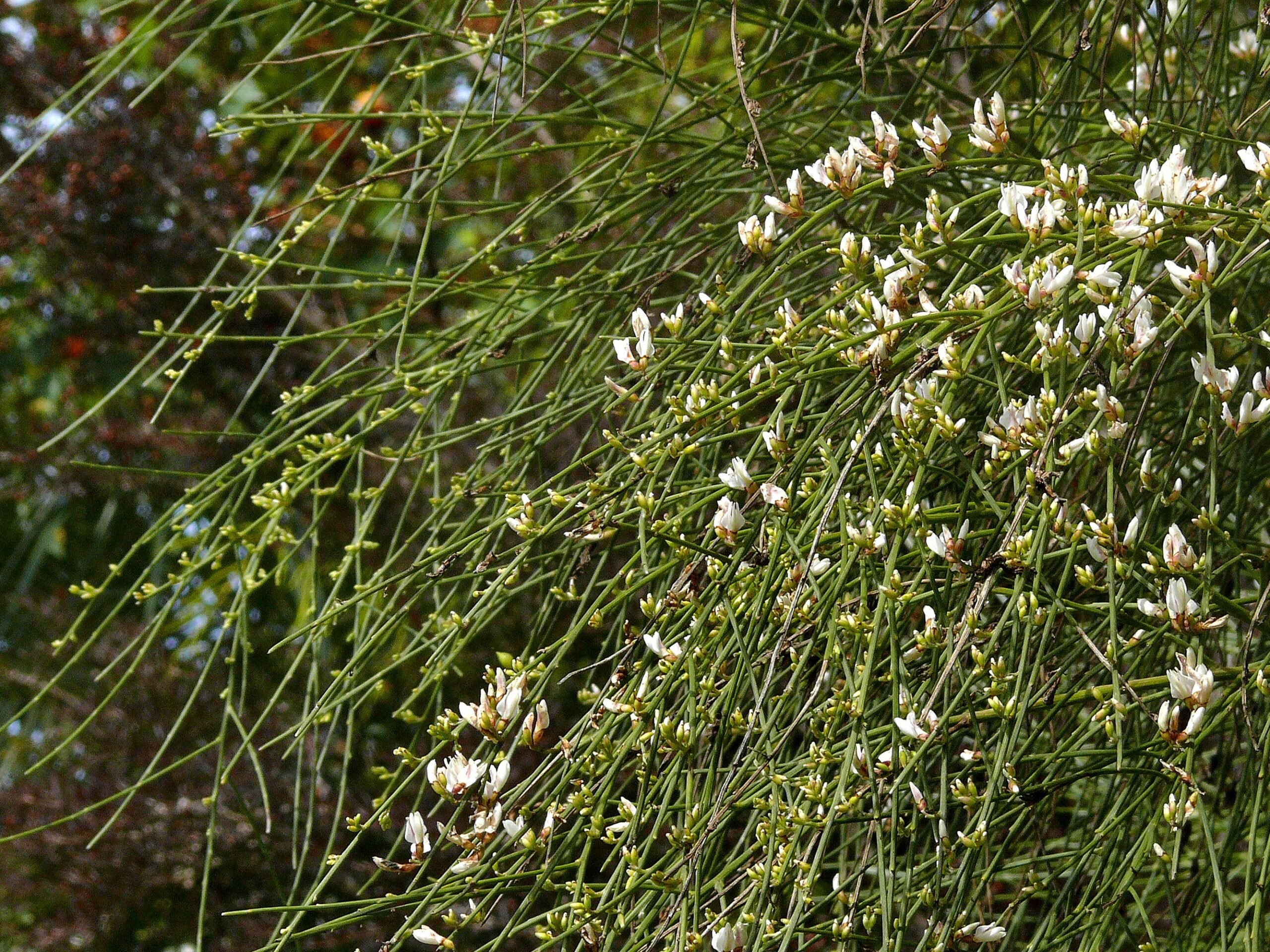
Genista monosperma Genista monosperma bridal veil broom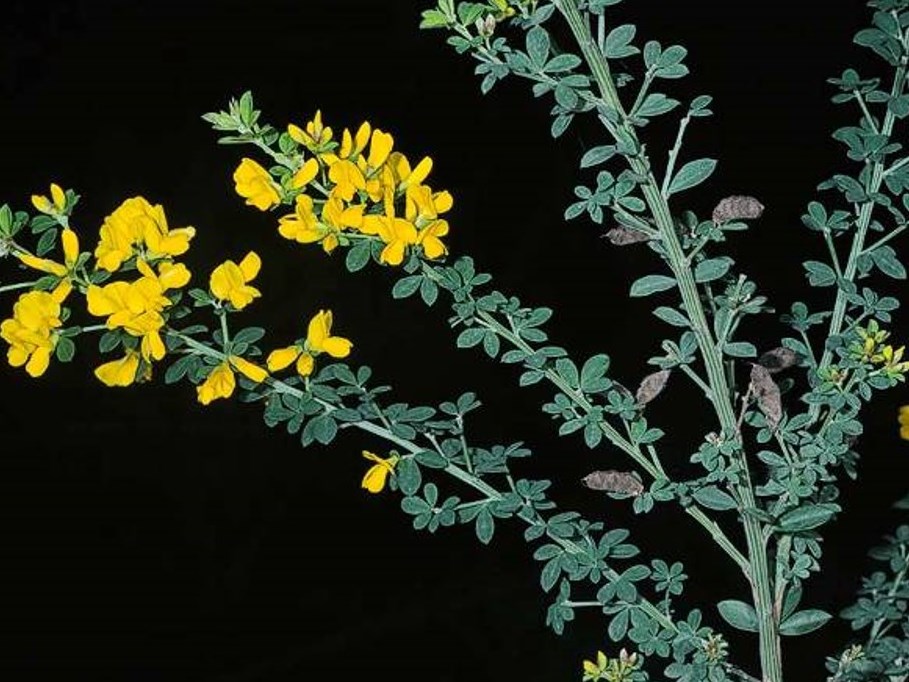
Genista monspessulana Genista monspessulana French broom; soft broom; canary broom; Montepellier broom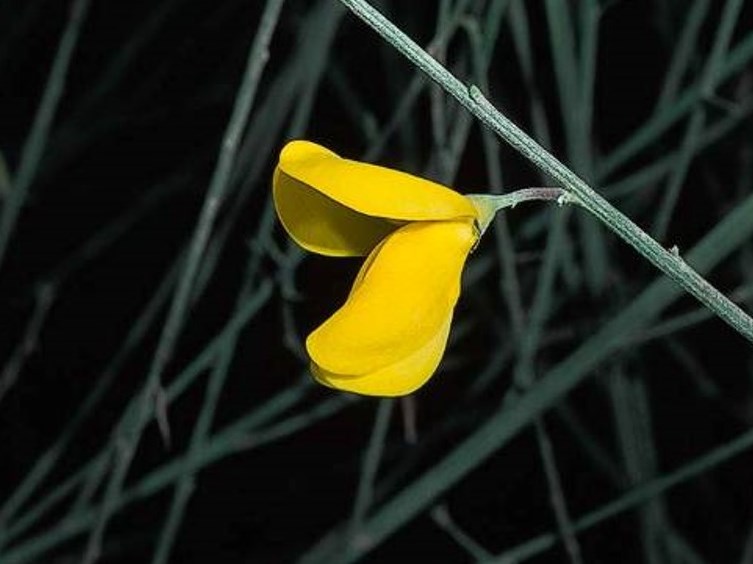
Cytisus striatus Cytisus striatus Portuguese broom; hairy-fruited broom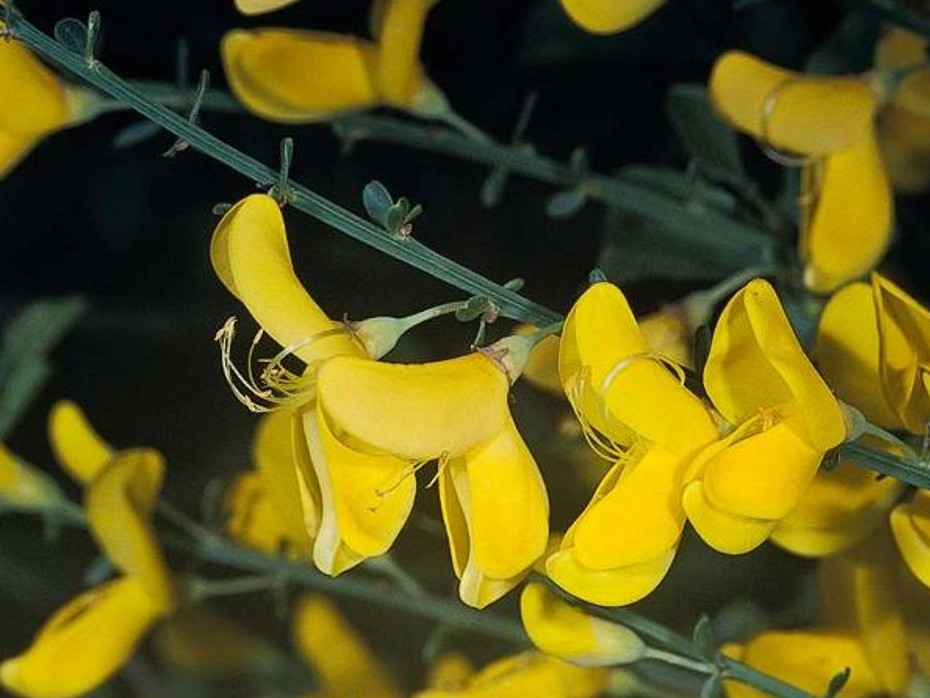
Cytisus scoparius Cytisus scoparius Scotch broom; English broom; common broom
Spartium junceum Spartium junceum Spanish broomBrooms have invaded over one million acres in California. The flowers produce thousands of seeds that build up in the soil over time, creating dense thickets that obliterate entire plant and animal communities. Grows quickly, creating a fire hazard in residential landscapes. "Sterile" varieties haven't been independently verified or tested and are not recommended as substitutes.
"Sweet broom" (Cytisus spachiamus or Genista racemosa) is not known to be invasive. However, because we lack information on its potential for invading wildlands, we do not recommend it as a substitute for other brooms.
Invasive: Do Not Plant -
Sesbania punicea (wisterias)

Sesbania punicea Sesbania punicea scarlet Wisteria; red Sesbania; rattlebox; Chinese WisteriaNew to California, spreading along the American River in central California. Also found in the Delta and in northern California. A serious problem in South Africa and Florida. Grows and spreads rapidly along river and stream corridors. Pushing out native vegetation and wildlife. Seeds are moved by washing downstream or are carried by birds.
Invasive: Do Not Plant
Recommended Shrubs for the Bay Area
-
Viburnum suspensum

Viburnum suspensum Viburnum suspensum sandankwa viburnumThis evergreen shrub produces tight clusters of small, waxy, pinkish-white flowers that give way to bright red berries. Several compact varieties are available. Deer resistant.
Sun:Water: -
Rhamnus crocea

Rhamnus crocea Rhamnus crocea redberryMedium evergreen California native shrub. Grows 4 to 10 feet tall, as wide as it is tall. Tight clusters of small, waxy, pinkish-white flowers give way to beautiful red berries in springtime. Several compact varieties are available.
Sun:Water: -
Ribes aureum

Ribes aureum Ribes aureum golden currentA California native, this shrub has a profusion of bright yellow flowers that turn into edible berries suitable for jams and jellies. Birds and butterflies love this plant. Deer resistant. Fire resistant.
Sun:Water:Bay Area native -
Phlomis fruticosa

Phlomis fruticosa Phlomis fruticosa Jerusalem sageA dependable, silvery-leaved shrub with whorls of yellow flowers that will thrive in any well-drained soil. Deer resistant.
Sun:Water: -
Jasminum nudiflorum

Jasminum nudiflorum Jasminum nudiflorum winter jasmineArching green stems and bright yellow flowers that bloom in winter characterize this deciduous shrub. Deer resistant.
Sun:Water: -
Kerria japonica

Kerria japonica Kerria japonica Japanese kerriaGolden yellow flowers first appear in spring on this graceful shrub, and continue into summer. Stems remain bright green in winter after leaves fall. Deer resistant.
Sun:Water: -
Eriogonum giganteum
Eriogonum giganteum St. Catherine's laceA California native, this freely branching, grayish-white shrub has white flowers that attract butterflies. Could overwhelm a carefully maicured garden.
Sun:Water:Bay Area native -
Feijoa sellowiana

Feijoa sellowiana Feijoa sellowiana pineapple guavaThis evergreen shrub has scarlet and white flowers, as delicious as they are beautiful, and waxy blue-green fruits with a minty-pineapple flavor. It is easily shaped into a small tree. Deer resistant.
Sun:Water: -
Forsythia

Forsythia x intermedia Forsythia x intermedia forsythiaOften the first plant to bloom in the spring, forsythia produces an astounding display of bright yellow flowers. Dozens of cultivars are available. Grows quickly.
Sun:Water: -
Galvezia speciosa
Galvezia speciosa showy island snapdragonA California native, this shrub has arching branches that increase in height up to eight feet tall. Produces copious red flowers that are irresistible to hummingbirds.
Sun:Water: -
Heteromeles arbutifolia

Heteromeles arbutifolia Heteromeles arbutifolia toyonThis California native is an evergreen shrub that produces delicate white flowers and large clusters of brilliant red berries that birds love. Can be pruned into a small tree. Deer resistant. Fire resistant.
Sun:Water:Bay Area native -
Hypericum rowallane
Hypericum 'Rowallane' shrub hypericumThis shrub produces bright yellow flowers through summer and fall. Tolerates poor soil. Deer resistant.
Sun:Water: -
Citrus mitus
Citrus mitis calamondin orangex Citrofortunella microcarpa calamondin orangeA natural hybrid between the tangerine and kumquat. Evergreen with shiny green leaves, and small, fragrant, waxy white flowers followed by long-lasting, bright orange fruits that make great marmalade.
Sun:Water: -
Arbutus unedo

Arbutus unedo Arbutus unedo strawberry treeA gorgeous, evergreen tree available in compact, shrub-like varieties that are easy to grow. It produces masses of beautiful white flowers and textured, strawberry-like fruits. Can be managed as either a shrub, with screening ability if left unpruned, or a tree.
Sun:Water:
Palms
Good news! There are no invasive Palms currently listed for this region.Invasive Trees of the Bay Area
-
Ficus carica (edible fig)
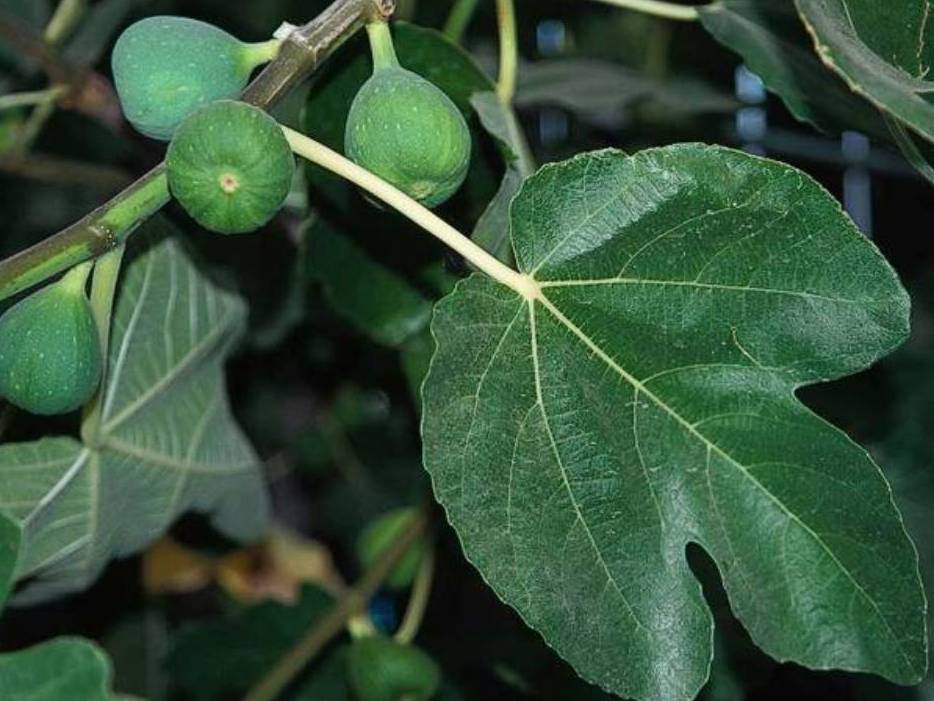
Ficus carica Ficus carica edible figCan be a problem in the San Francisco Bay area, the Central Valley, and southern California. May be spread by birds and deer, as well as by vegetation fragments. Can dominate stream and riverside habitat.
Invasive: Do Not Plant -
Myoporum (false sandalwood)

Myoporum laetum Myoporum laetum ngaio tree; false sandalwood; mousehole treeInvades along the coast from Sonoma County to San Diego. Forms dense stands with no other vegetation. Can cover large areas. Spread by birds. Leaves and fruits are toxic to wildlife and livestock. Burns easily. Doesn't typically spread in interior areas.
Invasive: Do Not Plant -
Schinus spp (pepper trees)

Schinus terebinthifolia Schinus terebinthifolia Brazilian pepper tree; Christmas-berry tree; Christmasberry; Florida holly
Schinus molle Schinus molle Peruvian peppertree; California peppertreePepper trees are native to South America (despite the fact that Peruvian peppertree is sometimes called California peppertree). Seeds are transported by birds and mammals into natural areas. The aggressive growth of peppers enables them to displace native trees and form dense thickets in natural areas. They produce undesirable suckering and sprout unwanted seedlings. A serious problem in southern California. Less of a problem in the San Francisco Bay Area and Central Valley, but care should be taken if planting near wildlands.
Invasive: Do Not Plant -
Ailanthus (tree of heaven)

Ailanthus altissima Ailanthus altissima tree-of-heaven; Chinese sumac; paradise-tree; copal-treeAlthough not commonly sold in nurseries, this tree is sometimes "shared" among gardeners. Tree-of-heaven produces abundant root sprouts that create dense thickets and displace native vegetation. These root sprouts can be produced as far as 50 feet away from the parent tree. In California, it is most abundant along the coast and Sierra foothills, as well as along streams. A single tree can produce up to a million seeds per year.
Invasive: Do Not Plant -
Eucalyptus globulus

Eucalyptus globulus Eucalyptus globulus blue gum; Tasmanian blue gum; blue gum Eucalyptus; common Eucalyptus; Southern blue gum; Victorian blue gumFound along the coast from Humboldt to San Diego and in the Central Valley. Most invasive in coastal locations. Easily invades native plant communities, causing declines in native plant and animal populations. Fire departments throughout Southern California recommend against using eucalyptus trees for landscaping because they are extremely flammable.
Invasive: Do Not Plant -
Elaeagnus angustifolia (Russian olive)

Elaeagnus angustifolia Elaeagnus angustifolia Russian olive; oleasterFound throughout California. Able to spread long distances with the help of birds and mammals. Invades river and stream corridors, pushing out native willows and cottonwoods. Reduces water levels. Provides poor wildlife habitat. Serious invader in other western states.
Invasive: Do Not Plant -
Tamarix (saltcedar)

Tamarix aphylla Tamarix aphylla athel; athel pine; tamarisk; evergreen saltcedar
Tamarix parviflora Tamarix parviflora smallflower tamarisk
Tamarix ramosissima Tamarix ramosissima saltcedar; tamariskA serious invader throughout California and southwestern states. Uses excessive amounts of water, increases soil salinity, changes water courses. Diminishes wildlife habitat, and increases fire hazard. Not commonly sold but still occasionally available.
Invasive: Do Not Plant -
Crataegus monogyna

Crataegus monogyna Crataegus monogyna English hawthorn; common hawthorn; oneseed hawthorn; May tree; singleseed hawthorn; azzarola; neapolitan medlar; oneseed hawthorn; whitethorn;An established invader of the Pacific Northwest, now spreading through northern California. Capable of long-range dispersal by birds. Creates dense thickets, changing the structure of woodland understories. May hybridize with and threaten native hawthorn species.
Invasive: Do Not Plant
Recommended Trees for the Bay Area
-
Tristaniopsis laurina
Formal plant; can be trained as a single or multistemmed tree. Mahogany-colored bark peels, revealing new, satiny white bark beneath. Yellow flowers produce a good show. Can be slow-growing. Damaged by very cold winters. Try cultivar 'Elegant'. Evergreen. Zones: 15-24. Height: To 45 ft. Width: 5-30 ft.
Sun:Water: -
Quercus macrocarpa
Rugged-looking tree with flaky grayish bark. Long, deeply-lobed leaves are glossy green. Large, distinctive acorns covered in fringed cap. Tolerant of poor conditions. Acorns can be a trip hazard. Deciduous. Zones: 1-11, 14-23. Height: 60-75 ft., equally wide when mature.
Sun:Water: -
Styrax japonicus
Slender, graceful trunk. Broad crown. Leaves may turn red or yellow in fall. Delicate, fragrant, white flowers hang below leaves, creating a layered effect. Deciduous. Zones: 4-9, 14-21. Height: 30 ft., narrow in youth, wide in maturity.
Sun:Water: -
Taxodium distichum
Delicate, feathery foliage sprays turn reddish-brown before dropping in the fall. Tolerates drought or very wet conditions, and any but the most alkaline soil. Trunk can be buttressed at the base. No pests or diseases. Easy to plant and care for. Tolerates any amount of water. Deciduous. Zones: 2-10, 12-24. Height: 50-70 ft. Width: 20-30 ft.
Sun:Water: -
Michelia doltsopa
Prune to create a narrow, upright tree. Furry brown buds open to cream or white blossoms. Thin, leathery, dark green leaves are red underneath. Evergreen. Zones 15-24. Height: To 25 ft.
Sun:Water: -
Lagerstroemia spp.
Stunning tree; great in a hot area. Showy summer flowers in hot pink, white, lavender, and other colors typically give way to brilliant fall foliage. Somewhat susceptible to aphids. Not the best choice for coastal locations. Deciduous. Zones: Varies by hybrid. Height: 8-25 ft., varies by hybrid.
Sun:Water: -
Liriodendron tulipifera
Straight, columnar trunk with a tall, pyramidal crown. Unique lyre-shaped leaves. Foliage starts bright green, turns bright yellow in fall. Tulip-shaped flowers in late spring are interesting but not showy. Beautiful large shade or lawn tree. Likes slightly acidic, well-drained soil and plenty of room. Deciduous. Zones: 2-12, 14-24. Height: 60-80 ft. Width: To 40 ft.
Sun:Water: -
Metasequoia glyptostroboides
Soft, pale green needles turn reddish-brown before falling in autumn, leaving a beautiful winter silhouette. Grows very fast when young. Older trees have fluted trunks. Resistant to oak root fungus. Not suitable for very arid regions or the coast. Deciduous. Zones: 3-10, 14-24. Height: To 90 ft. Width: To 20 ft.
Sun:Water: -
Elaeocarpus decipiens
New leaves rusty and hairy, turning smooth and bright green. Old leaves turn red before dropping. Blooms with tiny, scented, white flowers in clusters followed by small, blue-black, edible fruits. Likes rich, well-drained soil. Needs little pruning. Evergreen. Zones: 8-9, 14-24. Height: 30-60 ft. Width: 20-30 ft.
Sun:Water: -
Eriobotrya deflexa
Fast-growing and easily trained. New leaves emerge bright copper before turning green. Bunches of creamy white flowers in spring. Easy to plant and care for. Requires well-drained soil. Can be subject to fireblight. Evergreen. Zones: 8-24. Height: 12-30 ft. Width: 15-30 ft.
Sun:Water: -
Eucalyptus nicholii
One of the cleanest, most graceful eucalyptus, with weeping branches and not too much litter. Crushed leaves smell a bit like peppermint. Furrowed, rich, reddish-brown bark. Damaged by very cold winters. Evergreen. Zones: 5, 6, 8-24. Height: 36-48 ft. Width: 15-36 ft.
Sun:Water: -
Calliandra tweedii

Calliandra tweedii Calliandra tweedii Brazilian flame bushA small tree or shrub with leaves similar to scarlet wisteria and bright red flowers that attract hummingbirds and bloom all summer.
Sun:Water: -
Cassia leptophylla
Cassia leptophylla gold medallion treeBrilliant yellow flowers grace this tree throughout the summer, becoming attractive seed pods similar to those of scarlet wisteria. Larger than Sesbania, up to 25 feet tall.
Sun:Water: -
Chionanthus retusus
Blooms like clouds of the whitest, feathery flowers. Handsome bark provides winter interest. Will grow in most central California environments. The olive-like fruits can be a litter problem. May produce a significant amount of pollen. Deciduous. Zones: 3-9, 14-24. Height: To 20 ft., not quite as wide.
Sun:Water: -
Cornus mas

Cornus mas Cornus mas cornelian-cherry dogwoodA small tree that produces bright yellow flowers, which become bright red, edible berries that birds enjoy. Leaves may turn red and purple in fall.
Sun:Water:
Invasive Aquatic Plants of the Bay Area
-
Eichhornia crassipes (water hyacinth)

Eichhornia crassipes Eichhornia crassipes water hyacinthReputed to be the fastest-growing plant in the world! Can double in size in a week during hot weather. Forms dense mats that impede water flow. Seeds can live 15-20 years. The State of California has spent $45 million over 15 years to control water hyacinth in the Sacramento-San Joaquin Delta.
Invasive: Do Not Plant -
Hydrilla verticillata (water thyme)

Hydrilla verticillata Hydrilla verticillata Hydrilla; water thyme; Florida ElodeaIllegal to sell or possess in California. Has arrived in California mixed with shipments of water lilies and as a mislabeled aquatic plant. Fragments quickly start new colonies.
Invasive: Do Not Plant -
Lythrum salicaria (purple loosestrife)
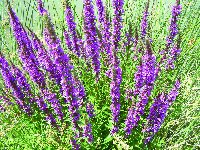
Lythrum salicaria Lythrum salicaria purple loosestrifeInvades streambanks and wetlands throughout the U.S. Persists year to year from root buds and from the root crown. Although not commonly sold in California, this plant is available for purchase on the internet. One plant can produce 2.7 million seeds. Has the potential to infest rice fields.
Invasive: Do Not Plant -
Ludwigia (waterprimrose)

Ludwigia hexapetala Ludwigia hexapetala creeping waterprimrose; Uruguay waterprimrose
Ludwigia peploides Ludwigia peploides floating water primrose; California waterprimroseCrowds out native plants and reduces water quality. Dense mats slow water movement and create habitat for mosquito larva, which can carry West Nile virus. Although there are native Ludwigia, do not collect them from the wild.
Invasive: Do Not Plant -
Iris pseudacorus (yellowflag iris)

Iris pseudacorus Iris pseudacorus yellowflag Iris; pale yellow IrisForms colonies along streambanks. Listed as a noxious weed in Nevada, Expanding in the Pacific Northwest. Uncommon in California, but causes serious problems in other regions with similar climates.
Invasive: Do Not Plant -
Salvinia molesta (giant salvinia)

Salvinia molesta Salvinia molesta giant Salvinia; karibaweed; water velvet; African pyle; aquarium watermoss; water fern; koi kandyIllegal to sell in the US. Floating mats up to 3 ft. thick reduce light and dissolved oxygen in the water so that few living things can survive. Common salvinia (Salvinia minima) may be sold, but species are difficult to tell apart.
Invasive: Do Not Plant -
Egeria densa

Egeria densa Egeria densa Brazilian Egeria; EgeriaInfests 7000 acres in the Sacramento-San Joaquin Delta. Aggressively invades natural waterways, displacing native aquatic plants and forming dense mats that impede water flow.
Invasive: Do Not Plant -
Myriophyllum spicatum (spike watermilfoil)

Myriophyllum spicatum Myriophyllum spicatum spike watermilfoil, Eurasian watermilfoilThe most widespread submerged invasive aquatic plant in California and a serious problem in Lake Tahoe. Stems are brittle and break easily, starting new infestations when spread by boats or water birds.
Invasive: Do Not Plant -
Myriophyllum aquaticum (watermilfoil)

Myriophyllum aquaticum Myriophyllum aquaticum parrotfeather; Brazilian watermilfoil; parrotfeather watermilfoil; thread-of-life;Forms dense mats that impede water flow. Stems are brittle and break easily. Spread by boats or migrating water birds. Uncommon in California but has the potential to spread.
Invasive: Do Not Plant -
Arundo (aquatic)

Arundo donax Arundo donax giant reedA serious problem in coastal streams. Dense growth damages habitat, while creating a fire and flood hazard. Variegated varieties are also problematic and are not recommended.
Invasive: Do Not Plant
Recommended Aquatic Plants for the Bay Area
-
Sagittaria spp.
Sagittaria latifolia arrowhead
Sagittaria montevidensis Sagittaria montevidensis arrowheadSagittaria lancifolia white swan, red swanPond Margin or Bog . Striking arrow-shaped leaves and white flowers. Grows in moist soil or water 6 inches or more deep. S. latifolia grows 12 to 20 inches; S. montevidensis to 4 feet. Also try S. lancifolia (white swan or red swan) for a specimen plant with green or red stems and a 7-foot flower spike.
Sun:Water:Bay Area native -
Mimulus aquatics

Mimulus guttatus Mimulus guttatus common yellow monkeyflowerPond Margin or Bog. Annual or perennial. Fills out a 4 feet x 4 feet space in spring and summer. May die back then return the next year. Yellow flowers with reddish spots resemble snapdragons. Hummingbirds like it; deer don't. Also try M. cardinalis for red flowers.
Sun:Water:Bay Area native -
Nuphar polysepalum
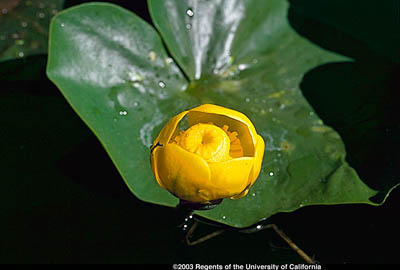
Nuphar polysepala Nuphar polysepala yellow pondlilyFloating or Rooted Emergent Plants. A native plant with a dramatic yellow flower and round leaves up to a foot in diameter. Foliage is submerged in winter and emerges in spring. May take more effort to find for sale.
Sun:Water:Bay Area native -
Polygonum amphibium

Polygonum amphibium var. stipulaceum Polygonum amphibium var. stipulaceum water smartweedSubmerged Plants. A versatile, creeping plant that does well in water depths ranging from moist soil to 4 feet of water over the crown. Long, narrow, floating leaves, and bright-pink flowers.
Sun:Water:Bay Area native -
Pontedaria cordata

Pontedaria cordata Pontedaria cordata pickerel weedPond Margins. Heart-shaped leaves surround dramatic flower spikes. Excellent filtration ability. Place in containers in 1 foot of water. 3 to 4 feet tall, 2 to 2 1/2 feet wide.
Sun:Water:Bay Area native -
Iris ensata

Iris ensata 'Variegata' Iris ensata 'Variegata' Japanese irisPond Margin or Bog
Sun:Water: -
Iris laevigata

Iris laevigata and cultivars Iris laevigata and cultivars laevigata irisPond Margin or Bog. A true water-loving iris that will do well in 6 inches of water. Flowers in white, purple, lavender, and pink. Yellow-blooming varieties are available, but rare. Leaves to 18 inches tall.
Sun:Water: -
Iris missouriensis

Iris missouriensis, I. longipetala Iris missouriensis, I. longipetala western blue flag irisPond Margins. A native iris with flowers ranging from white to blue to lavender. Leaves to 2 feet tall. Likes open, sunny, moist areas. Smaller in scale than yellowflag iris.
Sun:Water:Bay Area native -
Iris sibirica
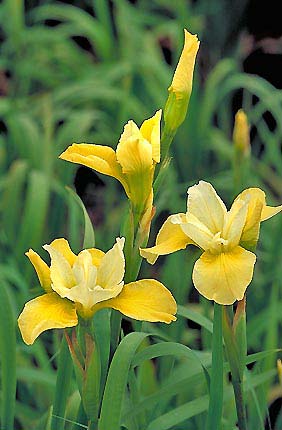
Iris sibirica and hybrids Iris sibirica and hybrids Siberian irisPond Margin or Bog.
Sun:Water: -
Juncus effusus
Juncus effusus common rushSun:Water:Bay Area native -
Ligularia wilsoniana
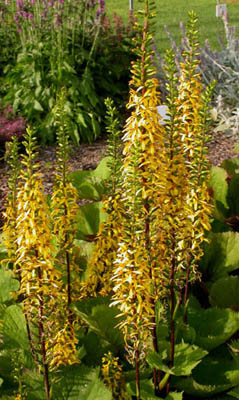
Ligularia wilsoniana Ligularia wilsoniana Wilson's ligulariaPond Margin or Bog. A tall and showy wetland perennial with spikes of bright yellow, daisy-like flowers. Stems grow to six feet tall.
Sun:Water: -
Lobelia spp

Lobelia cardinalis Lobelia cardinalis lobeliaLobelia fulgens lobeliaLobelia siphilica lobeliaPond Margin Plants. A spectacular blooming bog plant. Tubular flowers resemble honeysuckle or salvia and attract hummingbirds. L. cardinalis and L. fulgens to 6 feet with red flowers; L. siphilica grows 2 to 3 feet with blue flowers.
Sun:Water:Bay Area native -
Lysochiton americanum

Lysochiton americanum Lysochiton americanum yellow skunk cabbagePond Margin or Bog
Sun:Water:Bay Area native -
Marsilea spp.
Marsilea spp. water cloverFloating or Rooted Emergent Plants.
Sun:Water:Bay Area native -
Elodea canadensis

Elodea canadensis Elodea canadensis waterweedSubmerged Plants. One of the best oxygenating plants. Has dark green leaves and provides food and shelter for fish. Dies back in winter. Grows best in fine sand but may need to be controlled in small ponds. (Sometimes also sold under the name anacharis.)
Sun:Water:Bay Area native -
Brasenia schreberi

Brasenia schreberi Brasenia schreberi watershieldFloating or Rooted Emergent Plants.
Sun:Water:Bay Area native -
Ceratophyllum demersum

Ceratophyllum demersum Ceratophyllum demersum coontailSubmerged Plants. A rootless, deciduous perennial with slender stems and forked leaves. Tolerates shade and hard water. Good oxygenator.
Sun:Water:Bay Area native -
Chondropetalum aquatics

Chondropetalum tectorum Chondropetalum tectorum Cape thatching reedSun:Water: -
Cornus sericea

Cornus sericea Cornus sericea redtwig dogwood
Cornus sericea 'Flaviramea' Cornus sericea 'Flaviramea' yellowtwig dogwoodPond Margin or Bog. Brilliant red or yellow foliage and colorful winter twigs. Provide good screens where water is present. to 8 feet tall and 10 feet wide. Cut roots to control spread.
Sun:Water:Bay Area native -
Alisma plantago-aquatica

Alisma plantago-aquatica Alisma plantago-aquatica common waterplantainPond Margin or Bog. Herbaceous perennial with flowers heads arranged in whorls of white, pink, or lavender. Blooms form a pyramid-like shape. Suitable for medium to large ponds, but may overwhelm a small one. 12 to 36 inches tall and up to 18 inches spread.
Sun:Water:Bay Area native -
Aponogeton distachyon

Aponogeton distachyon Aponogeton distachyon cape pondweedFloating or Rooted Emergent Plants. Crisp white flowers with a vanilla scent are held on the water surface. Prefers cool water. May overwhelm a small pond.
Sun:Water: -
Azolla filiculoides

Azolla filiculoides Azolla filiculoides Pacific mosquito fern, fairy fernFloating or Rooted Emergent Plants. Tiny, free-floating perennial fern. Excellent pond cover for fish and other wildlife. Turns reddish-purple in the fall. To 1/2 inch high, with a spreading habit. May overwhelm a small pond.
Sun:Water:Bay Area native -
Baccharis salicifolia
Baccharis salicifolia mulefatPond Margin or Bog.
Sun:Water:Bay Area native -
Bambusa aquatics

Bambusa multiplex 'Alphonso-Karr' Bambusa multiplex 'Alphonso-Karr' 'Alphonso-Karr' bamboo
Bambusa multiplex 'Golden Goddess' Bambusa multiplex 'Golden Goddess' 'Golden Goddess' bamboo
Bambusa multiplex Bambusa multiplex bamboo (clumping species only)Pond Margin or Bog. Useful as a hedge or screen. Rhizomes of clumping species stay close to the plant and will not invade surrounding soil. Height varies by cultivar, up to 35 feet. Do not plant running bamboos, which spread aggressively.
Sun:Water:
